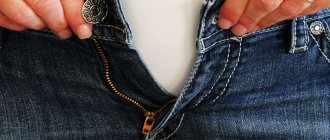At least once, almost every woman encounters such an annoying circumstance when, having washed her favorite item from her wardrobe and dried it, she suddenly discovers that not only has its original appearance changed, but the item has also shrunk. Basically, the reason lies in the wrong washing mode, when the product is washed, or in very hot water, or using the wrong detergent, and there is also a third option - the characteristics of the material from which the item is made.
Every housewife should understand that things can shrink due to the natural materials from which they are made. Therefore, to avoid such unforeseen situations, it is necessary to strictly follow the instructions that are indicated on the tag or label of the clothing.
If such an incident does occur and the item shrinks, you can try to return it to its normal state.
Appearance and main characteristics
100% polyester can be a thin translucent veil or a strong raincoat fabric. The appearance and properties of fabric made from polyester fibers depend on the chemical composition of the raw material, the shape of the fiber and the type of weave. Very often, polyester looks and feels like wool, but has properties similar to cotton.
- High degree of protection against adverse weather conditions (low temperatures, wind, ultraviolet radiation, rain and snow). Clothes made from polyester are almost always warm and dry.
- Wear resistance. Polyester fiber is resistant to stretching, friction and other types of physical impact.
- Easy care. Polyester is easy to wash, dries quickly and hardly wrinkles.
- Good drape. The fabric is easy to cut, sew and process.
- Color and shape stability. With proper care, polyester does not fade or fade.
- Light weight.
- Lower cost compared to natural fabrics.
- Protection from pests and mold. 100% synthetics will not interest moth larvae or other insects.
- Good water-repellent properties. In addition to protecting against precipitation, this quality prevents stains.
- Low elasticity. Thanks to this, the fabric does not stretch, and the clothes retain their shape well.
- Does not absorb odors.
Changing shape under strong heating can be attributed to both the disadvantages and advantages of the fabric. On the one hand, this provides additional opportunities when designing clothes or decorating. After all, to get all the necessary elements, it is enough to heat the fabric, form and fix the desired fold. On the other hand, careless ironing can result in an unwanted crease or fold in the clothing, which will be impossible to get rid of.
Thick knitwear, openwork lace, warm lining or smooth elastane are obtained by using different methods of connecting fibers and weaving threads. A variety of fabric textures will satisfy the most fastidious fashion designer.
Cons and weaknesses:
- High density. It is important to remember that the properties of pure polyester clothing make it not very comfortable to wear in hot weather.
- Inability to use chemical bleaches. Polyester fiber may break down.
- Electrification. Synthetics accumulate static electricity, which can cause dust particles to stick to clothing, and the fabric itself is attracted to the skin. These disadvantages can be easily eliminated if you use an antistatic agent or a special fabric softener. Many manufacturers add fibers with an antistatic effect to the thread composition.
- Some rigidity of the material. Sometimes elastane or cotton is added to make it softer.
- If the technology is violated, polyester fiber can cause allergies. When buying clothes, you need to remember that too cheap polyester can be harmful to health.
- The fiber is difficult to dye.
How to stretch a cotton T-shirt
Wet the item, place it on a flat surface, and stretch it to the sides. Using an iron at minimum temperature, iron the cotton with force, while pulling it to the side. Place the fabric on a towel, stretch it, secure it at the edges, and wait for it to dry.
Stretch cotton wide
You will need the help of another person. Wet the product and lay it on a towel. You should pull it wide, and at this time let the other person hold the bottom of the T-shirt, pressing it against the towel, so the product will not become shorter.
Stretch cotton lengthwise
Wet clothes in cool water and add regular shampoo. Squeeze it a little, spread it on the board and stretch it lengthwise. Secure the item with a weight and wait for it to dry.
How to stretch a woolen item
Wool is more capricious than cotton. Some housewives do not recommend stretching shrunken woolen items at all. However, there are ways. The only condition is that the item should not be too shrunken, otherwise you won’t succeed.
The most gentle method of stretching a woolen item is simple. Wet it and place it on a towel to absorb the water. Then begin to gently stretch the item in different directions, without being too zealous. Let it dry for a couple of hours and repeat the stretching again. By the time the item dries completely, you will have time to stretch it seven times.
There is a good way to stretch wool - convenient and loyal. You should soak the pullover in water with the addition of neutral shampoo. Then squeeze it lightly, wrapping it in a towel. Then stretch it on a board (preferably cork) and secure it with pins around the perimeter. Wait until it dries completely.
How to stretch something: a simple method
There is a universal way to stretch any thing. However, it is not always preferable as it can cause inconvenience. After moistening the item, put it on yourself and wait until it dries. The method is quite tough, not everyone can parade in wet clothes for a long time.
Separately, it is worth mentioning the hats. If the hat has shrunk, you can put it on a jar (about three liters in volume) and dry it. In addition, it is believed that it is always better to dry hats this way.
Sometimes situations may arise when your favorite T-shirt has decreased in size - this usually happens after washing. If you like to shop online, you can mix up the size and then you will have to either resell the purchased item or simply throw it away.
But don’t rush into drastic actions; there are several ways to stretch a product in length, width, increase it by a size, or return it to the previous size. It all depends on the type of fabric from which the product is made.
You may have gotten your size wrong when you made an online purchase, or your T-shirt has shrunk after washing, or you've gained weight— in any of these cases, you can correct the situation.
T-shirts made from natural fabric most often shrink in size after washing. Cotton fabric tends to shrink when exposed to high temperatures. Manufacturers add a synthetic component, elastane, to cotton, which prevents the product from pilling and tightening during and after washing. If trouble does happen and you need to increase the T-shirt by one size, you need to take a large towel, lay the wet product on it, carefully level it and dry it in this form - the T-shirt should return to its previous size.
Important!
To avoid troubles after washing, carefully read the information provided on the product label. Manufacturers always indicate the temperature permissible for washing. Be sure to follow the instructions provided.
Thigh cut
The hip cut can be high, medium or low and has a greater or lesser degree of freedom of movement. It is used to balance the cut and also affects the visual balance, so it is often selected based not only on considerations of convenience and ergonomics, but also depending on the type of figure. Whether you're preparing for a competition or going to the pool for the first time in your life, knowing that you look good gives you confidence and therefore also affects your results.
The general rule: a high neckline visually lengthens the legs and gives more freedom of movement, a low neckline visually lengthens the body and gives more compression to the muscles. In some countries, preferences depend on local customs; for example, in China, high necklines are not accepted - they are considered too vulgar.
The rules here are the same as for any other clothing: the color should be combined favorably with the color of your skin, black, as a rule, makes everyone look slimmer, vertical lines elongate the figure, horizontal lines create the opposite effect, a large pattern looks better with tall height and a slender figure.
To summarize, let us once again list the basic requirements for sports swimsuits for swimming:
The swimsuit must fit perfectly and fit tightly to the body; The swimsuit must provide freedom of movement; The swimsuit must provide muscle compression; The swimsuit must provide slip; The fabric of the swimsuit for exercising in the pool must be hypoallergenic, pleasant to the body, and resistant to chlorine if training takes place in the pool, or ultraviolet light and salt if training takes place in open water; The swimsuit should dry quickly.
Polyester is a successful synthetic fabric
Many people try to choose clothes made from completely natural fabrics, believing that synthetic material is harmful and uncomfortable to wear. This opinion is not entirely fair. High-quality polyester, produced using modern equipment, is not only safe, but also practical, beautiful and inexpensive material.
Polyester is a fabric made from polyester fibers.
It is worth considering that the inscription “100% polyester” can be on labels of products that are completely different in appearance and properties. The characteristics depend on the shape of the fiber and their additional processing.
There are two methods: stretching by washing and mechanical method
By washing
Items made of synthetics or combined materials should be soaked in cold water and thrown into the washing machine. Select a delicate wash program, do not add powder or gel, just run the program. Dry the product vertically, hanging it by one edge. Also, after washing, the T-shirt can be carefully laid out on the bedspread and evenly stretched in all directions. Leave the item to dry - this way it will stretch one size.
Knitwear can be stretched using hair conditioner, vinegar 3% and a simple sponge:
- Take a bowl of warm (but not hot) water and soak the product for 5 minutes.
- After five minutes, gently squeeze it out.
- Empty the water from the basin, put a T-shirt in it and moisten it with hair conditioner.
- Start stretching it, if you can’t do it well, add more conditioner.
- Rinse the item and wring it out a little.
- Distribute the T-shirt in the bathroom.
- Soak a sponge in vinegar and move it over the fabric, stretching it slightly.
- Select the delicate wash program and start the program.
- Rinse the item with regular fabric softener to get rid of the vinegar smell.
- Dry vertically.
Mechanically
You will need gauze, an iron, a clothes line and clothespins.
- Place the item in a bowl of water no higher than forty degrees and leave for ten minutes. Pull it out and squeeze it out with utmost care.
- Be extremely careful with drawings or prints - do not over-squeeze, as this may damage the image.
- Gently straighten the damp T-shirt on the ironing board and cover with gauze. Gently stretching it in the directions you need, steam it.
- Do not steam pictures and prints.
- Do not dry the item completely - secure it with the neck down using clothespins on a clothes line and leave to dry.
SWIMSUIT TYPE
As a rule, a one-piece swimsuit is better suited for swimming in the pool: it gives freedom of movement, does not slip anywhere and does not rub. You can swim in a two-piece swimsuit, but it is designed for a lower type of load.
Back
The cut of the back determines the fit of the swimsuit, muscle compression, glide and freedom of movement. There are many models and styles, but to simplify, all one-piece swimsuits are divided into two types: open back and closed back. All swimsuit backs will be just a variation of these two types and will contain either thin or thick straps. When choosing, it all depends on what is more important to you: compression and glide (closed back) or freedom of movement (open back).
Backless swimsuit
Such a swimsuit gives more freedom of movement in the water, but due to the open back, water resistance increases and, accordingly, gliding worsens. A swimsuit with a maximum open back is suitable for professional athletes or high-level amateurs who need maximum flexibility and freedom of movement. Such models are functional, look sporty and at the same time very stylish. A slightly more closed swimsuit offers greater compression and ergonomics combined with maximum comfort.
Swimsuit with closed back
Another option for a sports swimsuit is a model with a closed back and wide, soft straps. Thanks to this cut, water resistance is reduced, compression is increased and there is no discomfort in movements. Typically, swimsuits with a closed back are used by Water Polo players.
Athletes competing on the international stage choose professional starting wetsuits. They are more closed than classic ones: their length reaches the knee, and they help not only overcome water resistance, but also increase muscle compression.
Production
Pure polyester is made from oil, gas and their derivatives. The process takes place in several stages:
- Isolation of components necessary for the production of polystyrene (raw material for future fibers).
- Obtaining a melt - liquid polyester.
- Mechanical and chemical cleaning of polyester.
- Fiber production: The semi-liquid mass is pressed through very narrow holes.
- Finishing, refining and imparting additional qualities to threads.
- Direct production of fabric.
In an attempt to improve polyester, chemists combine polyester with various natural, synthetic and man-made fibers. The result is fabrics that are different from each other, not much inferior in quality and beauty to natural materials.
The quality of the fabric depends on compliance with the technological process. Good polyester does not have an unpleasant odor, such synthetics do not leave traces of paint on the skin and do not fade . In clothes made of high-quality synthetic material, you can comfortably play sports, relax or work physically.
How to stretch a cotton item
The most unpretentious fabric, comfortable and inexpensive is cotton. However, since the fabric is natural, it is subject to shrinkage. The easiest way is to soak a T-shirt or jeans in a vinegar solution and leave it there for a while. Take 3-3 tablespoons of vinegar per ten liters of water. To enhance the effect, you can simply wet a sponge with the same solution and wipe the laid out clothes, stretching the seams, sleeves and collar to the sides.
After this treatment, dry the item on hangers, or simply lay it out on a flat surface until dry. For the same purpose, you can add hydrogen peroxide to a container of water instead of vinegar. If the vinegar smell has not completely disappeared, wash the clothes again in cold water and add fabric softener.
A good stretching method is using an iron. Again, you need to wet the clothes, wring them out a little and dry them so that they are only slightly damp. Then iron from the inside out, trying to stretch it. Be careful here, as the iron can leave dark marks on light-colored items.
What to look for when buying a new product
- To buy a quality item of clothing, pay attention to the following nuances:
- The shoulder seams should run exactly along the edge of the humerus.
- Check the seams of things made from materials that stretch - they should not unravel.
- The sleeves of the product should not be tight; to check this, bend your elbows - if something is too tight, the item does not suit you.
- There are fabrics that wrinkle a lot when worn - these are natural materials such as linen or cotton. To check, squeeze the fabric in your fist; if it is very wrinkled, then you need to decide for yourself whether it is worth buying it.
To prevent clothing from shrinking, always look at the label on the back of the garment. He will tell you exactly how to wash and care for the item. But if the clothes have already shrunk, you can try to stretch them and return them to their original condition.
Soak clothes (anything except wool) in warm water for about 10 minutes. Then place it in the washing machine, add powder and turn on the gentle wash program. During the spin phase, the item should stretch. Take it out of the machine and stretch it with your hands to the desired shape, then hang it on a hanger to dry. Shake the item periodically during drying. Once completely dry, iron it. Remember that after washing, clothes should not be laid to dry on a flat surface. Otherwise she will sit down again. If a woolen item shrinks, unfortunately, you are unlikely to be able to return it to its original condition, since natural threads do not have the ability to stretch. But there are several effective ways that can work. Try drying a shrunken sweater (or other item) directly on yourself to restore it to its original appearance. The procedure is quite unpleasant, but you will go to great lengths for the sake of your favorite thing. You can also use hydrogen peroxide. Take 2 tbsp. l. peroxide per 10 liters of water. Shrunken clothes should be rinsed in this solution. Pull the item out while rinsing. Then leave it in this liquid for another 1.5 hours, then squeeze it out by hand and dry it on a hanger, stretching it every hour. For woolen items there is another radical method. You can unravel the threads, rewind them and knit a new item of the same model. Unfortunately, the method is not suitable for everyone, as it takes a lot of time and requires knitting skills. Before purchasing items made from wool, remember that they may shrink after the first wash, so it is preferable to choose an item one size larger. To stretch cotton items, use vinegar. Pour a small amount into a bowl, take a sponge and wet it. Then carefully handle the item. Place it in the washing machine and wash it. During the drying stage, the item will stretch. There is another option. Prepare a vinegar solution (1 teaspoon per glass of water) and soak the item in it. Then place it on any fabric. Use your hands to shape the garment into the desired shape and place something heavy around the edges to help it dry as needed. You can try to restore things in another way. In some cases, it even helps with shrinkage of wool products. To do this, clothes must be ironed and steamed. While ironing, stretch it across the ironing board to the required size. If your iron does not have a steam function, you will need gauze and a spray bottle of water. Place the item on the ironing board, spray it with water and apply gauze. Use an iron on top. Use your other hand to pull the fabric taut. The following method is suitable for clothes made of any fabric. It will help loosen and stretch the fibers. Soak clothes in water with baby shampoo or conditioner (1 tablespoon per 1 liter of water). Leave it in the soapy solution for 30 minutes, then twist it, but not too much. Place the item on a large towel and roll it inward with it. After 10 minutes, transfer it to dry material, straighten it and attach it to the towel with clothespins. Hang clothes on a hanger and dry in a dry, sunny place (if possible).
Inattention to detail often leads to improper washing and damaged items. There are things that need to be washed only by hand. The methods described above will not always give an effective result, so before washing, carefully study the information on the clothing label.
How to stretch a shrunken cotton or viscose item
There are many ways to stretch a shrunken cotton or viscose item, since these fabrics are more amenable to manipulation. The washing machine is set to the delicate cycle, the spin cycle is waited, after which the viscose or cotton knitted item is taken out of the drum and manually stretched to the required shape and size. After this, the product is hung on hangers and dried in a shaded place.
To return the shape of a cotton shirt, use a vinegar solution. Prepare a composition of 3 tbsp. vinegar and 10 liters of cold water. The shirt is dipped into the prepared solution and left for one and a half to two hours. After the specified time has passed, the item is removed and hung to dry without rinsing.
A very effective way to stretch out a shrunken item is to put it damp on the body immediately after washing (without drying). It is recommended to wear the product until it is completely dry. The method is unpleasant, but effective.
Of course, to avoid such cases, it is better to follow the recommendations on the product label. And if you have doubts that you will be able to wash the item yourself without unexpected results, then it is better to contact dry cleaners in Minsk, which are easy to find











